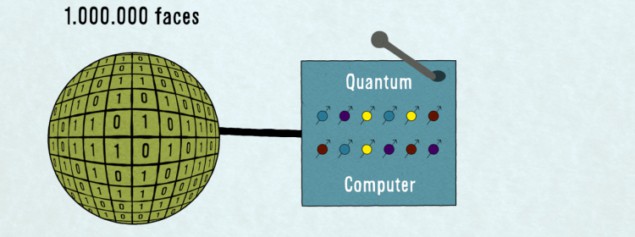
A new two-qubit quantum processor that is fully programmable and single electron spins that can be coherently coupled to individual microwave-frequency photons are two of the latest advances in the world of solid-state spin-based quantum computing. The breakthroughs could help in the development of large-scale spin-based processors in the future.
While classical computers store and process information as “bits” that can have one of two logic states – “0” or “1” – a quantum computer exploits the ability of quantum particles or bits (qubits) to be in a “superposition” of two or more states at the same time. Such a device could, in principle, outperform a classical computer on certain tasks, such as factoring large prime numbers and sorting large random lists, thanks to it being massively parallel.
In recent years, researchers have succeeded in making qubits from a number of solid-state materials, including semiconducting quantum dots and superconductors. Semiconductor spin qubits appear to be better for a number of reasons. For one, they last for a relatively long time before decohering (interacting with their environment). They can also be controlled electrically and can be integrated with high density on a chip.
The problem, however, is that it is still difficult to control the state of individual spin qubits and intertwine multiple qubits in a controlled way.
A complete set of operations in arbitrary combinations
A team at QuTech and the Kavli Institute of Nanoscience Delft led by Lieven Vandersypen and another led by Jason Petta at Princeton Universty have now succeeded in overcoming these problems.
Vandersypen and colleagues have made a new two-qubit device based on silicon that they can program to perform a complete set of operations in arbitrary combinations. “Such programmability means that the processor can run any algorithm the user designs and this is the idea people have in their minds of what a useful future quantum computer would look like,” explains team member and lead author of the study Thomas Watson.
A naturally “quiet” environment for qubits
The new device looks very much like a transistor, he says. “We apply control signals to metallic electrodes on a silicon chip to isolate, measure and manipulate the two electron spin qubits on the chip. As a proof of principle, we show that we can use these (electrical) control signals to run two different algorithms – the Deutsch-Jozsa algorithm (which tests whether a function is odd or even) and the Grover-search algorithm (which searches for the right answer in an unsorted set of data).”
The processor has the added advantage of being made from silicon, which provides a naturally “quiet” environment for qubits, he adds. Silicon is also the most widely used material in the semiconducting industry, so there is a great opportunity here to be able to scale up the number of qubits in our device, which would allow it to run more complex algorithms still.
Transferring information
Meanwhile, Petta’s team, which includes researchers from the University of Konstanz, has succeeded in coherently coupling a single electron spin with a single microwave-frequency photon. This has been difficult to achieve until now since spin qubits only weakly interact with their environment (a property that allows them to have a long lifetime, as mentioned).
“Such coupling is important because it allows us to transfer information from the spin qubit (which is stuck on a wafer) to a photon (which can be routed over relatively long distances on a chip),” explains Petta. “In the future, we should be able to couple any spin qubit on a processor to any other spin qubit on a processor using the photons as an information ‘link’.”
Faster than “bad” processes
The key here is for the spin to communicate with the photon in an extremely clean material system that allows for long spin coherence times, he says. “What happens naturally in most systems is that the photon leaks from its cavity, and the qubit quantum state collapses. We need to be able to couple the spin to the photon faster than the rate at which these ‘bad’ processes occur.
“In our work, we coupled silicon and superconducting niobium to couple semiconducting spin qubits to superconducting circuitry, a set up that allows us to trap the photon for a relatively long period.”
Fast spin-photon coupling rates
The operation time of such a device is slow, however, at around 0.1 seconds (which is like having a computer with a 10 Hz clock speed), explains Petta, so we sped up the interaction using a two-step process that couples the charge of the spin electron to the electric field of the photon cavity. “The spin of that same electron is coupled to its position due to a magnetic field gradient, which generates a spin-orbit interaction,” he says. “Combining the electric field coupling and spin-orbit coupling is what allows us to achieve the fast spin-photon coupling rates (of more than 10 MHz) we observed in our experiments.”
And that is not all. As well as demonstrating this spin-photon coupling, the Princeton-Konstanz researchers also found they could use light to measure the orientation of a single electron spin. “In the short term, we believe that the technology might be useful for high-fidelity readout of single quantum states,” Petta tells nanotechweb.org. “As mentioned, spin-photon coupling should also allow us to couple spins separated by large distances, and possibly even allow for chip-to-chip coupling.”
So, where next? Watson and colleagues say they will now be increasing the number of qubits in their devices and Petta’s team will couple one spin to another across a chip roughly 1 cm in size using a single microwave-frequency photon.
The research from both groups is published in Nature. Their papers are here and here.



